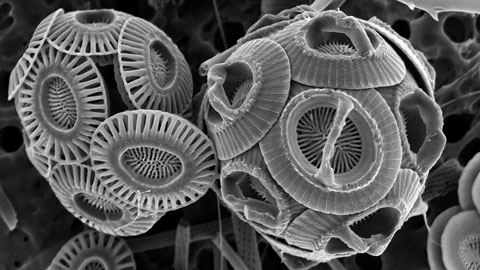Ocean fertilisation to mitigate climate change less effective than expected

11/11/2014
The fertilisation of oceans using large amounts of iron to increase the proliferation of plankton is a possible strategy against climate change. The strategy consists of mitigating the rise of atmospheric CO2 by incorporating increasing levels of this gas into ocean waters.
A research conducted by an international team of scientists included the participation of Patrizia Ziveri, ICREA lecturer at the Institute of Environmental Science and Technology ICTA-UAB. The findings were published today in Nature Geoscience and reveal that marine ecosystems respond in a complex manner to the iron fertilisation of oceans in the southern hemisphere, with a notable reduction in the effectiveness of transporting carbon dioxide to the bottom of the ocean. Researchers from France, Germany, Spain and the United Kingdom discovered that iron fertilisation fosters the growth of small shelled organisms which eat phytoplanktons. These organisms produce carbon dioxide when forming their calcareous shells.
Iron fertilisation is a natural process in the system analysed by researchers, near the Crozet Islands in the Indian Ocean. There, the growth and subsequent sinking of these marine organisms decrease the storage of carbon dioxide by 30 per cent. Ignoring the response of these organisms can represent an overestimated calculation of the effect iron fertilisation can have in the storage capacity of CO2.
Biological Pump of Carbon
The oceans of the southern hemisphere play a significant role in the exchange of carbon dioxide between the atmosphere and the ocean. Phytoplanktons act as a natural sponge which absorbs carbon dioxide, a problematic gas which has a greenhouse effect on the ocean. When the plankton dies, it sinks to the bottom of the ocean and stores part of the carbon dioxide it has absorbed, a process which scientists call the "biological pump" of carbon.
Even though many areas of the oceans in the southern hemisphere are rich in nutrients, they often do not have iron, which limits the growth of phytoplanktons. Oceanographers believe that adding iron to the ocean waters could stimulate the growth of phytoplanktons and therefore of the "biological pump" of carbon. Some scientists believe this process can partially explain the cycles of atmospheric carbon dioxide which have occurred on Earth in recent history, and its use as a means to mitigate climate change has been widely discussed.
In the past five years some studies have demonstrated that iron fertilisation can transport carbon dioxide to deeper waters. "However, to fully understand the storage of carbon dioxide inside the ocean, phytoplanktons are only part of the story", explains Dr Ian Salter of the Alfred Wegener Institute. " Phytoplanktons can be a source of food for certain types of animals, which in turn form shells made of calcium carbonate, a process which produces CO2".
The international team of researchers was the first to quantify production and sinking of these calcium carbonate shells resulting from a phytoplankton bloom in the area near the Crozet Islands, in the Indian Ocean. The results obtained were very surprising. The fertilisation, in this case occuring naturally, caused by the iron proceeding from the erosion of the basaltic islands, increased the production of these calcium carbonate shells and their posterior sinking more than the phytoplankton did. This phenomenon has important implications in the storage of carbon dioxide in comparison to the proliferation of phytoplanktons.
"The production and sinking of these calcium carbonate shells affect the balance of carbon dioxide on the ocean's surface during a time scale ranging from 100 to 1000 years", explains Patrizia Ziveri. "Our observations in this natural fertilisation system suggests that the process reduces up to 30% the amount of carbon dioxide transferred deeper into the ocean thanks to the phytoplanktons which sink to the bottom.¨
Researchers also observed that the decrease in the storage capacity of carbon dioxide is not caused solely by a larger abundance of shelled organisms which eat off of planktons, but also by the changes in composition of other species. "Among our samples of iron fertilised areas there are more species producing large amounts of carbonate shells which in turn produce more CO2 per individual." Iron fertilisation can, therefore, affect the biodiversity and structure of the ecosystems with important collateral effects on climatic interactions.
Patrizia Ziveri, ICREA lecturer at the Institute of Environmental Science and Technology of the UAB, studies how elevated levels of atmospheric CO2 affect calcareous planktonic organisms, as well as how these levels affect the climate and marine life.